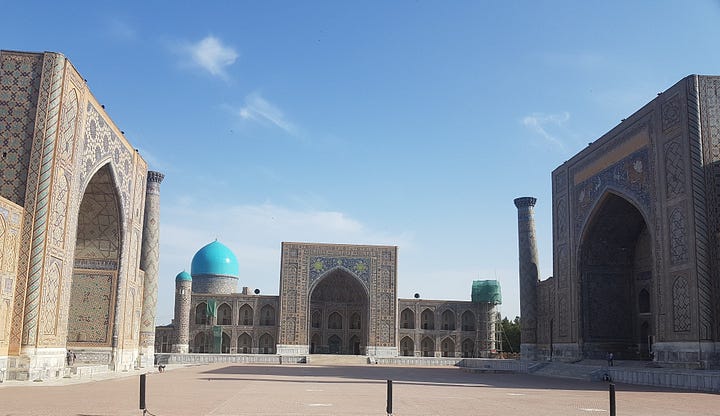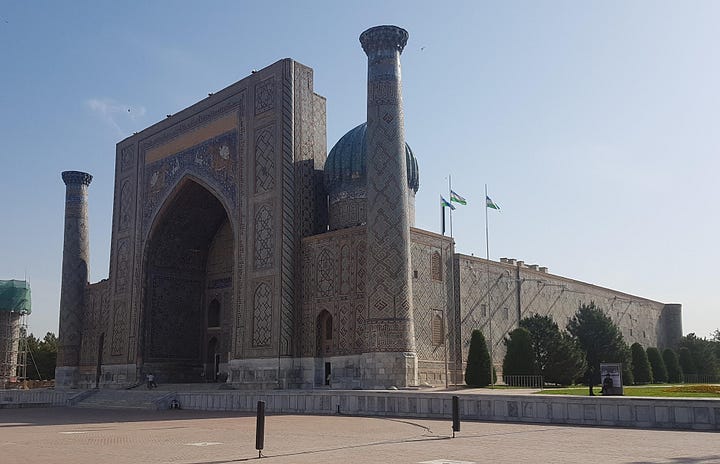Not so much a destination as a sound waiting to be heard. The locals pronounce it ‘Samarrrkand’ with a soft central (almost Northumbrian) burr and an extended final vowel, as though they’re reluctant to let it go. It's ‘a heart-stealing sound’ according to Colin Thubron.
It first stole my heart many years ago, when I heard the lines ‘We take the golden road to Samarkand’ by James Elroy Flecker but they’ve stayed with me ever since, evoking a journey as mysterious and ethereal as time.
The Merchants: Away, for we are ready to a man! Our camels sniff the air and are glad. (Others try to tempt them to remain in Baghdad) The Draper: Have we not Indian carpets dark as wine Turbans and sashes, gowns and bows and veils The Grocer: We have rose-candy…and oil and spice And such sweet jam One of the Women: O turn your eyes to where your children stand. Is not Baghdad beautiful? O stay! The Merchants: We take the golden road to Samarkand A Pilgrim: It’s sweet to ride forth at evening from the wells When shadows pass gigantic on the sand And softly through the silence beat the bells Along the golden road to Samarkand.
The scene ends with the Merchants and Pilgrims faintly singing in the distance, their voices fading into the desert.
We’re staying on the outskirts of the modern city and it’s difficult to see how (and where) it might contain the ancient wonders we have come to see. I decide to go for an early morning walk, leaving Eil to catch up on her sleep. I hadn't intended to walk as far as the Registan with its miraculous madrasahs but I’m drawn irresistibly towards it. The road may not be golden but it’s alive with the morning rush: cars, buses, taxis, shopkeepers opening their doors, kids in navy blue uniform, bakeries selling takeaway snacks for breakfast. An ordinary Tuesday morning but not for me…my excitement is growing.
At the end of the road, there is an area of quiet parkland, in contrast to the bustle of the city. It feels as though the trees are welcoming me with their cool, timeless embrace accompanied by a greeting in birdsong. This clears my mind and the park is like a bridge between the modern city and the peaceful, perfect pattern of the old square.
The Registan was the heart of the ancient city and means ‘sandy place’ in Persian. It dates back to the Timurid Empire and was originally an open market place. In 1417, Ulugh Beg, the grandson of Timur (aka Tamburlaine) ordered the building of the first madrassah (meaning ‘teaching and learning place’) that was later renamed in his honour. Two centuries later, two more madrassahs were built to complete the ensemble that can be seen today. They are Sher-Dor (1636) and Tilla-Kori (1660). At this time, Samarkand was capital of the Timurid Empire and an important trading centre on the Silk Road.
Basil Bunting writes about what he calls ‘the implausible optics’ of Islamic architecture in his Ode 36:
See! Their verses are laid as mosaic gold to gold gold to lapis lazuli white marble to porphyry stone shouldering stone, the dice polished alike, there is no cement seen and no gap between stones as the frieze strides to the impending apse: the rays of many glories forced to its focus forming a glory neither of stone nor metal, neither of words nor verses, but of the light shining upon no substance; a glory not made for which all else was made.
Bunting captures one of the visual miracles of Islamic architecture as he writes ‘there is no cement seen and no gap/between stones’ only ‘the light/ shining upon no substance’. As I look at tiny blue, yellow and turquoise mosaics forming intricately interwoven patterns and scriptures, it seems as though these madrassahs must have been constructed from nothing more than imagination and faith. Receding contours, multiple mouldings and deep concave channels of sunlight and holy geometry beckon me towards them.
We visited and passed the Registan several times during our five days in Samarkand and never quite got over it. Each time, the buildings took on new forms, emitting different moods and sensations. We couldn’t stop gazing at the sacred symmetry of the square and its ancient buildings made of light.









beautiful
Great writing, and so evocative of the lovely times on holiday when you can slip away from the crowds and experience something amazing in peace. Hope there is more to come from the Silk Route.